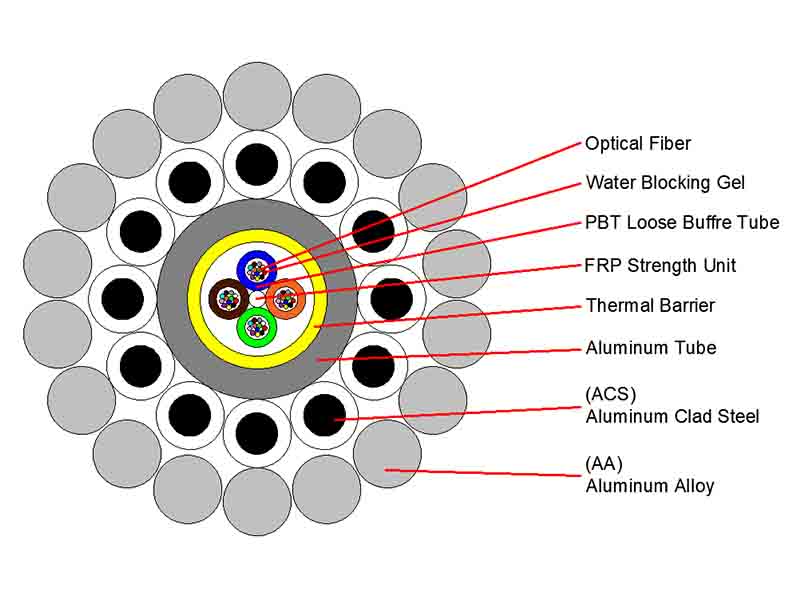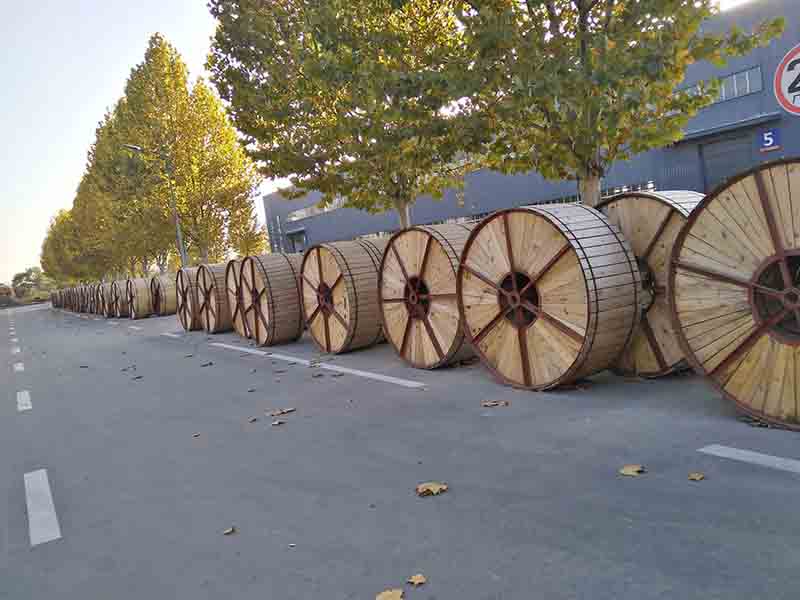
The OPGW optical cable is placed in the ground wire of the overhead high-voltage transmission line to form the OPGW optical cable communication network on the transmission line. This structural form combines the dual functions of ground wire and communication,and is generally referred to as OPGW optical cable. Due to the characteristics of anti electromagnetic interference and light weight,OPGW optical cables can be installed on the top of transmission line towers without considering the optimal mounting position and electromagnetic corrosion. Therefore,OPGW has significant characteristics such as high reliability, superior mechanical performance,and low cost.
The design of OPGW optical cables consists of fiber optic cores (with multiple subunits based on the number of fibers),which are wrapped in sealed hardened aluminum tubes and covered with one or more layers of steel and/or alloy wires. The types of OPGW optical cables include:
ACS (aluminum clad stainless steel tube) OPGW optical cables are the preferred choice due to their central aluminum clad stainless steel tube and color coded optical fibers, which simplify the fusion process while providing the best fiber protection and long-term product reliability.

Twisted tube OPGW optical cables use fiber containing stainless steel pipes twisted together with aluminum clad steel and/or aluminum alloy wires to form a multi-layer optical cable design suitable for various environmental and geographical conditions,and can adapt to a higher number of optical fibers.

The central tube OPGW optical cable is favored for its compact size and the ability to accommodate up to 48 fibers in products of the same diameter. The central stainless steel tube is covered with a layer of aluminum clad steel and/or alloy wires,which provides a more robust configuration than bare stainless steel tubes covered only by wires.

ACP (Aluminum Clad PBT) OPGW optical cables are the preferred choice due to their central aluminum tube and color coded fiber optic buffer tubes,which simplify the fusion process while providing the best fiber protection and long-term product reliability.

OPGW optical cables have all the advantages of traditional shielded wires,such as providing short-circuit grounding paths and protecting circuits from lightning strikes,and have good compactness. In addition, they also provide optical paths for communication,which are highly stable,highly reliable,high tensile strength,high communication quality,low cost,low transmission signal loss,anti electromagnetic interference,less prone to theft,and less susceptible to destructive attacks.
1、 Optical fiber composite overhead ground wires (OPGW), also known as OPGW or OPGW optical cable, are the combination of optical fiber media in the overhead ground wire of transmission lines, integrating lightning protection and communication functions, and possessing dual functions of traditional overhead ground wire and optical fiber communication capabilities. Place optical fibers in the ground wire of overhead high-voltage transmission lines to form the optical fiber communication network on the transmission line
2、Optical unit: A component composed of optical fibers and protective materials. The protective material can be metallic or non-metallic, T can form the load-bearing part of the OPGW, and the metal protective material can also form the part of the OPGW that transmits current.
3、Rated tensile strength (RTS): The tensile strength calculated based on the structure of the optical cable, which is the sum of the product of the bearing cross-sectional area, minimum tensile strength, and stranding coefficient of each load-bearing component.
4、Maximum allowable tension (MAT): The maximum horizontal tension that OPGW can withstand under the expected worst operating conditions
5、Annual average operating tension (EDS): The tension at the lowest point of OPGW sag under no wind, no ice, and annual average temperature conditions
6、Heavy ice area: areas with a designed ice thickness of 20mm or more
7、Rare wind speed, rare ice cover: Severe strong winds and ice cover that do exist in history and significantly exceed the frequency curve recorded over the years.
8、Large crossing: the line crosses navigable rivers, lakes or straits. Due to the large span (more than 1000m) or high tower (more than 100m), the conductor selection or tower design needs special consideration, and in case of failure, it will seriously affect navigation or repair the tension section with special difficulties
9、Aluminum clad steel wire: A circular wire composed of a round steel core wrapped with a uniform and continuous aluminum layer
10、Aluminum alloy wire: a circular wire made of heat-treated aluminum magnesium silicon alloy material
11、Tension to weight ratio: The ratio of the rated breaking force of OPGW to the calculated mass per unit length, abbreviated as the tension to weight ratio, unit:Km
OPGW optical cables are used in the power industry,transmission and distribution lines (500KV、220KV、110KV voltage level lines),voice,video,data transmission,SCADA network,Ariel ground wire,and dark fiber optic leasing.
OPGW optical cables not only maintain all the performance of overhead ground wires,but also open up the way for fiber optic communication networks without the need for an additional hanging line. OPGW has significant advantages such as high reliability,superior mechanical performance, and low cost.
OPGW Cable Detail reguirements need to be sent to us for cable desian and price calculation. Below requirements are a must.
A、Power transmission line voltage level
B、fiber count
C、Cable structure drawing & diameter
D、Tensile strength
E、Short circuit capacity

